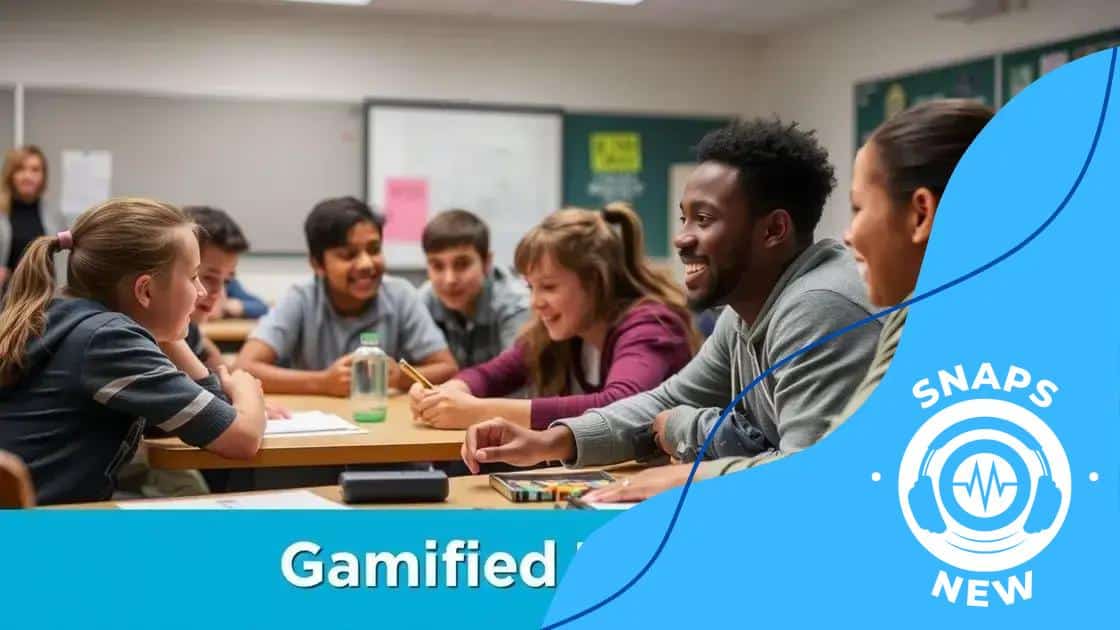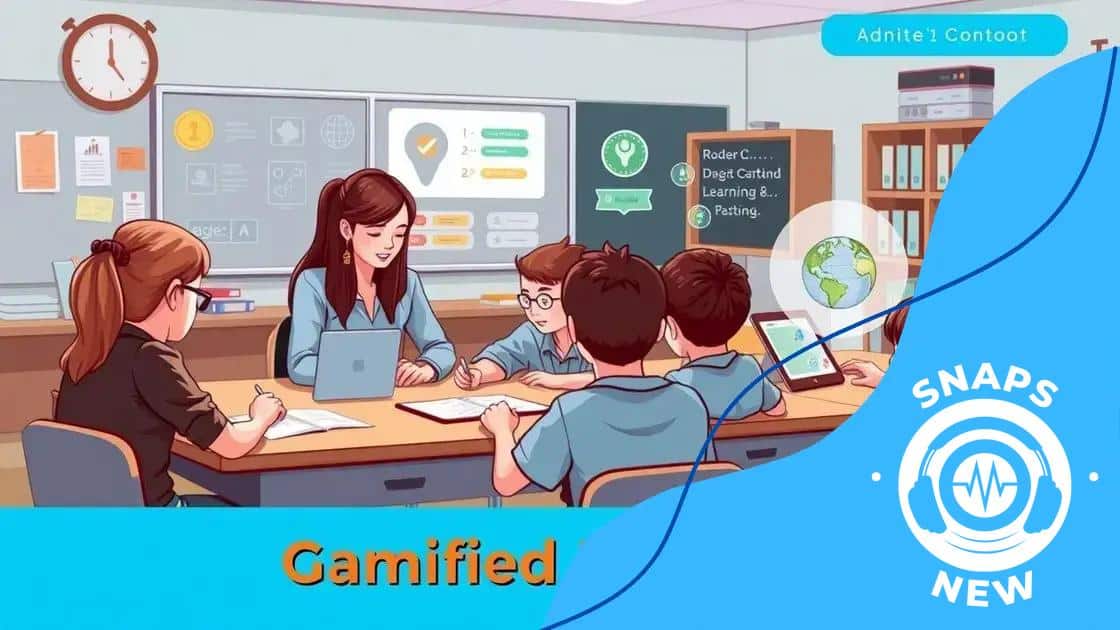Gamification in education: unlocking engagement for students

Gamification in education enhances student engagement by integrating game elements like points, badges, and challenges into learning activities, creating a more interactive and motivating environment.
Gamification in education is transforming how students learn and engage with materials. Have you ever wondered how game-like elements can make lessons more exciting? Let’s dive into this innovative approach.
Understanding gamification in education
Understanding gamification in education is crucial for anyone looking to engage students effectively. This approach integrates game-like elements into learning to make it more interactive and enjoyable. It taps into the natural desire for competition and achievement, driving students to participate actively in their education.
Key Concepts of Gamification
When we dive into gamification, we encounter several essential concepts. These ideas help educators implement successful strategies. Here are some key elements:
- Points: Reward students for completing tasks and participating in class.
- Levels: Create progression systems where students can advance through levels as they master the material.
- Badges: Offer badges for specific achievements, providing recognition for effort and skills!
- Leaderboards: Display student rankings to encourage friendly competition.
Using these elements can lead to a more engaging environment, where students feel accomplished and motivated. In addition, it fosters teamwork and collaboration among peers.
Benefits of Implementing Gamification
Implementing gamification in education can increase not only engagement but retention of information as well. Students learn better when there’s a fun challenge involved. It makes them want to achieve and learn. This fun approach can reduce stress associated with traditional learning methods.
Furthermore, by integrating games into the curriculum, students often develop essential skills, such as problem-solving and critical thinking. Gamification also encourages creativity by allowing students to express themselves through various activities.
One significant advantage is that gamification can cater to various learning styles. Visual learners might enjoy interactive videos, while kinesthetic learners could benefit from hands-on activities that involve movement. By offering diverse approaches, all students can thrive.
Incorporating gamified methods creates an environment that doesn’t just teach but inspires, making learning a delightful journey.
Benefits of gamification for students
Exploring the benefits of gamification for students reveals many reasons this method is gaining popularity in education. When students engage in gamified learning, they often experience increased motivation and enthusiasm for their studies. Gamification transforms traditional lessons into exciting challenges that invite participation.
Increased Engagement
One notable benefit is the boost in engagement levels among students. Incorporating game elements draws them into the learning experience. Rather than passively absorbing information, students become active participants. This shift is crucial for maintaining focus and interest.
- Interactive Learning: Gamified lessons involve students through hands-on activities.
- Instant Feedback: Students receive immediate responses, allowing them to learn from their mistakes.
- Ownership of Learning: Gamification encourages students to take charge of their educational journey.
- Peer Interaction: Group activities promote collaboration and communication skills.
The competitive aspect of gamification can also help students push themselves further. They see rewards or recognition not just as incentives but as proof of their hard work and progress. This motivates them to try harder and achieve their goals.
Skill Development
Another vital aspect of gamification for students is the development of essential skills. While participating in gamified activities, students practice critical thinking, creativity, and problem-solving. These skills are relevant both inside and outside the classroom.
Moreover, gamification fosters a sense of community within the classroom. By working toward common goals, students learn to support each other, making the learning environment more positive. They also develop perseverance as they tackle challenges, which can lead to increased resilience.
Incorporating gamification helps students build confidence. When they achieve game-related tasks, they feel accomplished, boosting their self-esteem. This newfound confidence can lead to greater overall success in their academic journeys.
How to implement gamification strategies

Implementing gamification strategies in education can transform how students engage with learning materials. It’s not just about adding games but designing experiences that encourage participation and excitement. Let’s explore some effective ways to bring gamification into the classroom.
Start with Clear Goals
The first step is to define clear objectives. Knowing what you want to achieve helps shape your gamification efforts. Are you looking to improve engagement, enhance retention, or foster teamwork? Setting specific goals allows you to tailor your approach effectively.
- Define Learning Outcomes: Identify what skills or knowledge students should gain.
- Involve Students: Get input from students on what they find motivating and engaging.
- Choose Relevant Content: Ensure the game elements support your curriculum.
- Measure Success: Decide how you will evaluate the impact of gamification.
Once your goals are established, you can create a strategy that includes game mechanics such as points, badges, and rewards. These elements encourage participation and make learning fun.
Incorporate Game Mechanics
Implementing effective game mechanics is crucial in bringing gamification to life. Elements like points, levels, and challenges can enhance the learning experience significantly. For instance, consider rewarding students with points for completing assignments or participating in discussions. This approach can lead to friendly competition.
Levels can also motivate students, as they see their progress charted visually. This visibility helps them understand where they stand and encourages them to keep striving for higher achievements. Here are some engaging examples:
- Challenges: Create tasks that challenge students and promote critical thinking.
- Rewards: Offer badges for specific accomplishments, building a sense of achievement.
- Leaderboards: Display rankings to foster a sense of community and competition.
- Feedback: Provide instant feedback to keep students informed of their progress.
Moreover, an effective gamification strategy keeps students interested. They’ll look forward to lessons as they become part of an exciting game, encouraging ongoing participation. The effectiveness of gamification often lies in the combination of intrinsic and extrinsic motivators.
As you implement these strategies, continually assess their effectiveness. Be open to feedback from students, adjusting your approach based on what works best for your classroom dynamic. Gamification should foster a positive educational environment, making learning interactive and enjoyable.
Successful examples of gamification in classrooms
Successful examples of gamification in classrooms demonstrate how engaging techniques can enhance learning experiences. Schools around the world are using these methods to motivate students and improve educational outcomes. By integrating game elements into everyday lessons, educators create a dynamic and interactive learning environment.
Case Study: Classcraft
One standout example is Classcraft, a game-based learning platform where students can earn points and rewards for positive behaviors and academic achievements. In this system, students take on character roles and collaborate to complete quests and challenges. The system promotes teamwork, responsibility, and accountability.
- Engagement: Students are more motivated when they can see their progress visibly.
- Behavioral Management: Many teachers report improved classroom behavior.
- Collaboration: Classcraft encourages teamwork through group tasks.
The role-playing aspect of Classcraft allows students to experience lessons in a fun and immersive way, making learning enjoyable and memorable. This method proves particularly effective in fostering strong peer relationships.
Example from Duolingo
Another noteworthy instance is Duolingo, a language-learning app that employs gamification to teach languages. It uses points, levels, and achievement badges to keep learners engaged. Users can track their progress and compete with friends, which adds a social aspect to language acquisition.
Duolingo’s approach shows that learners can stick to their study routines when they feel they are playing a game. This demonstrates that gamification not only applies to traditional classrooms but can also extend to digital learning environments.
Gamified Math Lessons
Teachers have also implemented gamification in math lessons. For instance, by using online platforms like Kahoot or Quizizz, instructors create quizzes where students can compete against each other in real-time. Students earn points for correct answers, enhancing the excitement and urgency of learning.
- Instant Feedback: Students receive immediate results on their answers.
- Increased Retention: The competitive element helps in better retention of knowledge.
- Fun Environment: Gamification turns learning into an enjoyable experience.
These successful implementations show how gamification can enhance the learning experience for students. By seamlessly integrating game mechanics into educational practices, teachers can foster an atmosphere where students thrive.
Challenges and solutions in gamifying education
Gamifying education offers many advantages, but it also comes with unique challenges. Understanding these challenges and finding solutions is essential for educators who want to implement gamification effectively. This approach can modify lessons and boost student engagement, but it requires careful planning and execution.
Time and Resource Constraints
One significant challenge is the time and resources needed to create gamified lessons. Teachers often juggle multiple responsibilities, making it tough to design and implement gamified activities. To address this, educators can start small by incorporating simple game elements into existing lessons.
- Use Existing Tools: Leverage online platforms that offer gamified features.
- Collaborate with Colleagues: Share resources and ideas with fellow teachers.
- Start with Low-Prep Games: Implement quizzes or challenges that require minimal preparation.
Using these strategies can help teachers integrate gamification into their classrooms without feeling overwhelmed.
Student Resistance
Another challenge is resistance from students who may not see the value in gamified learning. Some students might prefer traditional teaching methods. Introduce gamification gradually and explain its benefits. Highlight how it can make learning more enjoyable and interactive.
Additionally, allowing students to provide feedback can encourage a sense of ownership in the process. When they have a voice, they’re more likely to embrace gamified elements.
Tech Issues
Technology can also present challenges in a gamified classroom. Issues like unreliable internet connections or limited access to devices can hinder the experience. To mitigate these problems, ensure that students have access to the necessary technology before implementing gamified lessons.
- Plan for Offline Activities: Create activities that do not require technology.
- Have Backup Plans: Prepare alternative methods of delivery in case of tech failures.
- Offer Tech Training: Provide students with basic training on using the necessary tools.
Proactively addressing these technology concerns can enhance the success of gamification in education.
Finally, it’s important for teachers to remain flexible and willing to adapt their methods. As they experiment with different gamified strategies, they can identify what works best for their students. Ongoing evaluation and adjustment will make it easier to overcome challenges and enhance learning through gamification.
FAQ – Frequently Asked Questions about Gamification in Education
What is gamification in education?
Gamification in education involves using game elements in learning activities to enhance student engagement and motivation.
How can gamification improve student motivation?
By incorporating game-like features such as points, badges, and challenges, students feel more excited and involved in their learning process.
What are some challenges of implementing gamification in classrooms?
Challenges include time constraints, student resistance, and technology issues, which can affect the effectiveness of gamified strategies.
Can gamification work for all subjects?
Yes, gamification can be adapted to fit various subjects and learning styles, making it a versatile tool in education.





